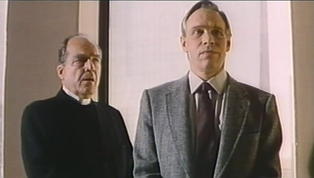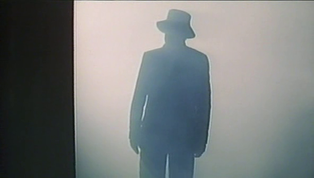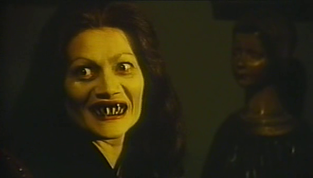The Spider Labyrinth (1988)
- nickkarner
- Jun 20, 2022
- 7 min read

In Laurence Fishburne’s introductory scene in Abel Ferrara’s black hearted King of New York, he unexpectedly puts extra emphasis on his final word when he asks a fellow gangster from another crew: “You ever get the feeling you was being WATCHED?!” Sure, Fishburne’s Jimmy Jump has just taken a big snort of cocaine, so his paranoia is increased tenfold. If he happened to find himself in Budapest during the events of Gianfranco Giagni’s The Spider Labyrinth (1988), I think he’d be reduced to a quivering mess of nerves. It seems as though Budapest is made up of nothing but looky-loos, staring at the visiting American language professor Alan Whitmore (Roland Wybenga, Sinbad of the Seven Seas) while he tries to figure out what the hell is going on. While the paranoid thriller had its heyday in the 70’s, anxiety and suspicion are not bound by time periods, so the fear of being constantly stared at by multiple individuals remains a fundamentally uncomfortable situation.

The brilliance of documentary and television director Giagni’s first feature is the way in which he steadily builds tension while never leaving the viewer bored or restless. The film clearly borrows from Italian masters like Mario Bava, Dario Argento, and ultimately Lucio Fulci as far as giallo elements, moody lighting, desolate locations, and finally Lovecraftian body horror, but the film never feels derivative. Point in fact, nothing particularly gory or scary even occurs for nearly 40 minutes, but the payoff is very much worth it. Of course, the story of an outsider being sent on a fact-finding mission to a strange, mysterious place is a well-worn trope (The Wicker Man springs to mind), but Giagni injects an impressive level of palpable dread as the professor sinks deeper and deeper into this odd, insular society. Producer Tonino Cervi (Red Desert) had developed the screenplay for The Spider Labyrinth with Riccardo Aragno and Cesare Frugoni (Bava’s Rabid Dogs), but since it had been kicked around for many years, Giagni enlisted the help of his future Valentina collaborator Gianfranco Manfredi to update the script, transporting the action from Venice, which Nicolas Roeg had already effectively made terrifying in Don’t Look Now, to the baroque and cobblestone-covered streets of Budapest.

Professor Whitmore “Call me Alan” suffers from recurring nightmares stemming from a childhood incident where a friend locked him in a closet with a huge spider. Despite a poorly dubbed child (whose voice is clearly a woman trying to sound like a young boy), it’s a creepy thought to be trapped with an arachnid of unusual size. Summoned to the impressive office of a Reverend Bradley, Alan is part of a massive research project called “Intextus” which is being worked on all over the world. One of their most important researchers, Professor Roth, has broken off contact with the home office. Would you like to know the most shocking part of this movie? Spoilers! At the end of a phone call, the characters actually say “bye” to each other. GASP!! Seriously, it was actually jarring. The opening credits are accompanied by an oddly-chosen theme that resembles music from the 1940’s. When Alan is told he’ll meet with Roth’s assistant, I bet my bottom lire that the assistant was some sexy dame.
Sure enough, there she is in all her flirty, brunette glory as Genevieve (Paola Rinaldi, U2’s “All I Want is You” video) drives him to his hotel, where he’s immediately stared at by the various residents. Giagni is helped immeasurably by the moody, elegant score by Franco Piersanti (Nanni Moretti’s regular composer) and a clever use of Dutch angles courtesy of DP Sebastiano Celeste (La Piovra). The cinematography in general is excellent, despite my watching it from a VHS copy, with a roving, sometimes even rotating camera. One can tell the film is shot with attention paid toward isolation and despair.
Alan is greeted by Roth’s wife Celia, played by Romanian actress Margareta von Krauss, who has the look of The Trunchbull from Matilda and the demeanor of Ilsa, She-Wolf of the SS. Professor Roth has had a nervous breakdown, but once she’s out of the room, he hands off some secret papers and photographs before he’s interrupted by a large black ball smashing through his window. You damn kids! Later, Alan reads them and we get classic lines like “I found the sarcophagus” and “It’s a labyrinth without an exit.” Classic stuff we’ve come to expect from films like these. Proclaimer of doom William Berger, noted anti-establishment wild man character actor from Luigi Cozzi’s Hercules, shows up to warn Alan that he’ll be “sucked into the vortex!” Alan returns to find Roth strung up and dead, spider webs intermingling with rope. I’ve never understood how cops in movies just bring random people into a crime scene willy-nilly without at least warning them that they’re about to see a dead body. Alan’s getting weirded out because the window is no longer broken and Professor Roth had no wife. Who the hell was that weird lady?
Giagni’s film owes a debt to Polanski as well, particularly in a scene where a naked Genevieve writhes against a window across from Alan’s hotel. A chambermaid, Maria (Claudio Muzii, Malena), attempts to warn him, but she’s chased off by hotel owner and black cat enthusiast Mrs. Kuhn (BAFTA winner Stephane Audran, Babette’s Feast, The Discreet Charm of the Bourgeoisie). Maria soon finds herself in a maze (a...labyrinth, if you will) of sheets and she’s pursued and finally stabbed by a seriously freaky woman with huge red hair and even bigger fangs. It’s a scary scene filled with green lights and disembodied hands grasping for her through the sheets. The startling appearance of the spider woman (again played by Von Krauss) is jarring, to say the least, and the shrieking, growling noises she produces are upsetting. For a while, I thought perhaps this woman was the black cat seen earlier, but that doesn’t appear to be the case.

When you hire Stephane Audran, you’d better give her something to do, so she gets an effective speech about her deceased son. She shows Alan a scar on her wrist which she claims was the result of a botched suicide following the death of her son. Alan asks “Why not consider light instead of darkness?” She responds: “There is no God. There is no light. There is nothing.” While Alan takes her words as merely the utterings of a woman who’s suffered an unimaginable tragedy, he’ll soon discover she’s speaking about something quite different and altogether more sinister.

Genevieve points Alan in the direction of an antique dealer who may have the tablet Roth took pictures of, and we get a nice scenic tour of Budapest, which would be lovely except for the fact that everyone seems to be in on it. No matter what, he can’t find his way to the store and at times, he’s the only one on the street while the wind whips around him. The freaky woman appears and beats the shit out of the antique dealer, finally pinning him to the wall with a knife.

The mysterious man (Berger) re-appears and leads Alan down into the sewer, where he’s unfortunately a current resident. He gets some fabulously apocalyptic dialogue, describing an ancient religious sect known as The Weavers who “want to use” him. They take their victims and “christen them in a labyrinth of death.” His most alarming remark is “Their gods aren’t myths, they’re living creatures.” Of course, the film’s minor weakness is that whenever someone helps the main character, they soon die, but Berger’s death is at least an act of defiance. Alan runs off through the catacombs, climbing over debris, decay, and various dead bodies, but Berger stays behind, yelling “I’m not afraid” to whatever it is that’s coming. Another black ball shows up, this time cracking open, revealing a stop-motion spider. The spider lady snatches him up and spews webbing from her mouth before stabbing him in the neck.
In a few predictable but enjoyable beats, a police officer turns out to be a part of the sect due to the similar spider-like scar that Mrs. Kuhn had earlier. Alan escapes, but Genevieve arrives and gets sexy with him for a while before her spider scar is revealed. It’s all obvious and has the film's most Wicker Man-feel to it, although that’s certainly only one of many examples one could pull from with this type of story. I believe the reason Alan suddenly appears loopy and disoriented is because she slimes him with some goo, but despite his hallucinatory, drugged-out state, he’s able to fend off the spider woman’s attack, even killing her by stabbing her in the neck with a huge glass shard.
Genevieve leads him into a kitchen-like room where several of the hotel residents are waiting around a slab, including Mrs. Kuhn. She tells him he’s been “chosen” and that his participation will make “the cobweb bigger.” She also tells him not to be afraid, but he should be very afraid. Before I reveal the absolutely terrifying finale, I think it’s important to note the incongruity at play here. If they “chose” him, then why was the spider lady trying to kill him? Did The Weavers want her to be murdered? Genevieve does mention that after he kills her, he’s “ready,” but what would’ve happened if she killed him? It’s a clumsy, confusing bit where the filmmakers clearly wished to have some more action to keep the pace up. It’s not egregious, but it could be done better.
A mutant baby thing with bright red eyes emerges from a sarcophagus and sprouts hairy legs in a bloody display of practical effects by Sergio Stivaletti and Barbara Morosetti, who between them have amazing credits like Demons, Opera, Apocalypto, Cemetery Man, and The Church. It becomes a stop-motion spider that’s admittedly a bit rough around the edges but it doesn’t detract from the horror of the moment. A particularly neat touch is its baby face while the spider’s multi-eyed head rests on top of the baby’s cranium. They cut open a spot on Alan’s arm and although we don’t see, it’s assumed that the giant spider shrinks itself to crawl inside the wound, which closes up and becomes the familiar spider scar. He returns to Dallas and when informed that Roth sent the religious leaders polaroids of the sacred tablet, he proceeds to tear them apart.
Although this is a fun ending and I tend to hate the very over-used trope of a monster attacking the camera, I’d’ve been fine with a spider-like creature leaping at the camera. For now, Alan simply pops around the corner, complete with giant fangs, and the film ends on a freeze frame.

The Spider Labyrinth is a sadly forgotten gem of a horror film, mixing elements of many different styles and genres into a cohesive form. It’s tense, mystifying, and quite frightening by the end.
































































Comentários